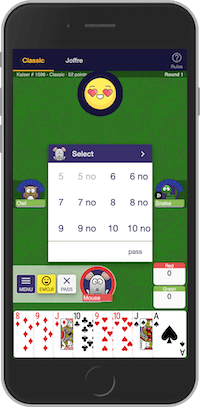Overview
Kaiser is a German trick taking game where teams of players try to be the first to reach 52 points. Kaiser is played with four players divided into two teams.
Ranking of Cards
In Kaiser, Aces are high and 3s are low
Presets
- Classic: Standard Kaiser as outlined in this guide
- Joffre: A preset of Kaiser that uses specialty cards instead of traditionally suited cards. Players compete to 40 points with a minimum bid of 5. No trumps and max non-bid are disabled. First card led by the declarer determines the trump
Play Multiplayer Kaiser Online
The Deck and the Deal
Kaiser is played with a German 32 card deck, with Aces through 8 in each suit; the four additional cards are the 7 of Clubs and Diamonds, 5 of Hearts, and the 3 of Spades. After the teams are decided amongst the players, the dealer shuffles the deck and passes out 8 cards, one by one, to each player.
How to Play
Auction
Beginning with the player left of the dealer, players bid on how many points they can make in the round. The minimum bid is 6 and the maximum bid is 12. Players must raise a bid made or pass. Players can signal that they want to bid without trump by saying no after their bid. A no trump bid is ranked higher than a trump bid. Once all players pass after a bid is made, the winner of the bid becomes the declarer. The declarer decides on the trump suit for the round.
If all players pass before a bid is made, the dealer must make a bid of 6. This is called Sticking it to the Dealer.
Play
The declarer leads the first trick. Gameplay continues clockwise. Players must follow the lead suit if possible. If no trumps are played, then the highest card in the lead suit wins the trick. The winner of a trick leads the next trick. Gameplay continues until all cards are played.
Cards in tricks won are then tallied for points.
Scoring
Each trick won by a team is worth 1 point. An additional 5 points are given to the team who won the trick containing the 5 of Hearts. A penalty of 3 points is given to the team who won the trick containing the 3 of Clubs.
If the bidding team met their bid, their collective points are added to their score. If they failed to meet their bid, their collective points are subtracted from their score. If they played no trumps, then their score is doubled and either added or subtracted depending on if they met their bid or not.
If the non-bidding team has a score below 45, their points are added to their score. If they have a score of 45 or more, their points are not added to their score.
Winning
Traditionally, the team who reaches 52 points first wins the game, however, at CardzMania, you can decide the winning-point threshold.
Variations
CardzMania supports several customizable rules and options so you can play Kaiser exactly how you like or how you grew up playing with your friends and family. In addition to the classic way of playing, we often have new creative options for you to try to spice up the game if you are interested in trying different spins for fun.
Points
Players determine a set amount of points when the game ends.
Rounds
Players determine a set amount of rounds (also known as hands or deals) that the game will go to (instead of the points selection above).
Timer
Players only have a set amount of time to make their turn after which a turn is automatically played for them and the game proceeds: Fast is 7 seconds, Standard is 15 seconds, Slow is 30 seconds, and Very Slow is 60 seconds. Players can also choose to disable the timer, but that is only for private tables.
Min bid
Players can decide the minimum bid. The options that are available are 5, 6, 7 or 8.
Trump lead
Players can decide to make the lead card trump if they are playing Joffre.
Max non bid
Players can decide the maximum number of points the non-bidding team can have before the tally cut-off. The options that are available are 30, 35, 45, 47, 50, 55, 56 and 60. This restriction can also be disabled.
No trumps
Players can decide if they want to allow no trumps in bidding.
Low bids
Players can decide to reverse the ranking of the cards and whether this option should always be available or only when no trumps are called.
Kitty
Players can decide to make a two card kitty pile in the dealing process that is to be taken by the declarer.
Stick the dealer
Players can decide if the dealer can pass or not if everyone else has passed.
Trick Basics
Trick Taking games center around having the highest ranked card in a draw. Typically, players of trick taking games sit in a circle, sometimes in teams and sometimes playing solo, and are dealt a hand of cards. Given the specific game's card ranking (and trump - special suit that beats other suits), players draw a card from their hand in hopes that it outranks the other cards played. The player who outranks the others wins the trick for that round and gameplay is repeated until the cards are exhausted. Typically the player or team with the most tricks wins the game.
In a trick, each player plays a single card. One player is selected to start, then play proceeds clockwise around the table. If possible, players must play a card which is the same suit as the first card played - this is called 'following suit'. If a player cannot follow suit, then they may play any card in their hand. Based on the cards played, one player is declared the winner of the trick, usually for playing the highest value card of the trump suit, or of the suit of the card which started the trick.
After all cards have been dealt, normal trick taking commences. Remember all cards of the suit declared as trump (trump cards) beats any other suit. Whichever team wins seven tricks out of thirteen wins the round, winning all thirteen tricks is referred to as court. If the dealers team achieves this feat, its called a goon court. In single sir, winning the first seven consecutive tricks constitutes a court.
After cards dealt, depending on the trump, you have to figure out your strategy for the game whether to play trump first or not. In single sir / single sar winning the first seven tricks constitutes as a court or a goon court, so the strategy is very different than double sir / double sar. Whichever team (dealers team or trump callers team) wins seven tricks wins the deal and the opposing team becomes the dealer. In double sir, you have to win two consecutive tricks, so the strategy is totally different as you need to keep another high card to win the pile. Note that the second and the second last trick cannot be won, so you have to be extra careful about that too. This game is played in many variations so you have to be extra careful about the rules.
Based on the cards played, one player is declared the winner of the trick, usually for playing the highest value card of the trump suit, or of the suit of the card which started the trick.
Hand
The cards that a player is dealt forms their hand. Each round, a player selects one of the cards in their hand and plays them into the pile. In most trick taking games, all players are dealt the same number of cards and the hand is hidden from the other players, but in some games, like 500, a player can reveal their hand for bonus points.
Pile
The pile is the spot where players place their chosen card for the round. The player with the highest ranked card receives all of the cards in the pile and sets them to the side. In most trick taking games, the individual cards in the pile have a specific point value that is given to the winner.
Dealer
The dealer is chosen at random and passes out the deck of cards to form each player's hand. In most games, the dealer position rotates to the left once the deck needs to be re-shuffled and re-dealt.
Trump
Arguably the most important part of any trick taking game, the trump suit is the highest ranked suit in the game. Every game has its own method of selecting trump. Some games leave the selection up to the winner of the bid while some games make the suit of the lead card the trump suit.
Order
The ranking of the cards is dependent on the game. Ace is usually considered the highest in trick games, but some games from Europe, like Klaverjassen, have the Jack of trump the highest card.
Auction/Bidding
Most trick taking games contain an auctioning/bidding phase at the beginning of gameplay. During this time, players take turns bidding how many tricks they expect to win in the game. The player with the highest bid leads the first trick and decides the trump suit in most games. Often times, if the winner of the bid, sometimes called the declarer, fails to win the amount of tricks they bidded, they receive a lot of penalty points
Lead Card
The Lead card is the first card in the trick. In most trick taking games, subsequent players need to play the suit of the lead card if they can.
Card Game Basics
A deck of cards consists of 52 cards, with 4 distinctive subgroups. Each of these subgroups is recognised by a symbol and are referred to as suits. They consist of Clubs, Spades, Hearts and Diamonds. Each suit contains 13 cards which, generally, are considered in this order, Ace (A), 2, 3, 4, 5, 6, 7, 8, 9, 10, Jacks (J), Queen (Q) and King (K). Some games include the two Jokers found in a standard deck but most games don't.
Feedback
Would like to discuss new features or variations for Kaiser? Need a custom rule? Have a question? Got a suggestion? Don't see a game you want to play? Please contact us by
email, facebook or twitter - we really value your feedback and love hearing from all of you!
This site uses cookies. By continuing to browse the site you are agreeing to our use of cookies.




